Author: Kevin Li Artemis Researcher, Translator: Shaw Golden Finance
Summary:
1. Stablecoins have limited upside: Circle's IPO highlights the prospects of stablecoins, but Coinbase only accounts for a small part of the economic benefits of USDC. According to the revenue sharing agreement, Coinbase obtains about 60% of USDC's total revenue, but only retains a small part of it, because about 43% will be distributed to users as revenue, which means that Coinbase only accounts for about 34% of the total stablecoin revenue.
2. The regulatory moat gradually fades: Coinbase benefits from regulatory uncertainty and uses its expensive compliance infrastructure as a competitive moat. However, in an environment with stricter regulation and greater transparency, this advantage gradually weakens as competitors become more viable.
3. Exchanges under pressure: Affected by fee compression and growing competition from ETFs, decentralized exchanges (DEX), and retail-focused TradFi platforms such as Robinhood, Coinbase's core trading commission rate has dropped from 2.5% to 1.4%, and its market share has dropped from more than 58% to about 38%.
4. Diversification of revenue sources: Coinbase is expanding subscription services (Coinbase One), staking, USDC interest income, and derivatives businesses to offset the impact of weak spot trading volumes. The proportion of trading revenue to total revenue has dropped from more than 90% in the previous cycle to about 55% in this cycle.
5. Base is gaining traction: Base, Coinbase’s Ethereum Layer 2, is expanding rapidly in both volume and profitability—currently leading all Ethereum L2s in volume and active addresses—but still lags behind Solana in overall user activity and adoption momentum.
5. Derivatives gaining momentum: Volume has surged to over $300 billion per month, but monetization and long-term growth remain constrained by aggressive liquidity incentives and fierce competition from ETF-based crypto options.
6. Valuation looks attractive: Comprehensive analysis shows Coinbase’s valuation at around $95 billion, but the market correctly reflects structural risks to its exchange moat and long-term profit margins.
Coinbase’s Path to Ecosystem Giant
To understand the challenges Coinbase faces today, and why it cannot fully replace Circle, it is important to look back to its origins. Coinbase began as a simple cryptocurrency exchange at a time when buying Bitcoin was still complex for the average user. With an intuitive and easy-to-use platform, Coinbase quickly gained a large number of users. Coinbase's early and proactive regulatory compliance strategy gave it a significant advantage, allowing it to expand its business in both retail and institutional markets.
This foundation built on trust, accessibility, and legal clarity has enabled Coinbase to build a dominant trading business and a loyal user base. From there, the company turned its focus to expanding monetization opportunities. It launched Coinbase One, a premium service, and launched a staking product that allows users to earn a yield on their assets, which aims to deepen user engagement and diversify revenue.
 As Coinbase's brand and influence continue to expand, Coinbase and Circle launched USDC, a stablecoin positioned as a compliant alternative to USDT and BUSD. As a key bridge between fiat and cryptocurrency, Coinbase's platform integration and reputation have accelerated the popularity of USDC. Rising interest rates (up to around 5%) have further increased the interest income of USDC reserves.
As Coinbase's brand and influence continue to expand, Coinbase and Circle launched USDC, a stablecoin positioned as a compliant alternative to USDT and BUSD. As a key bridge between fiat and cryptocurrency, Coinbase's platform integration and reputation have accelerated the popularity of USDC. Rising interest rates (up to around 5%) have further increased the interest income of USDC reserves.
To complete its ecosystem, Coinbase launched the Ethereum Layer 2 chain Base in 2024. With this chain, Coinbase now controls a full-stack infrastructure: exchanges, stablecoins, and blockchains - a vertically integrated crypto ecosystem.
The exchange business and the brand it has built have always been the engine of Coinbase's broader ecosystem. Subsequent product launches are not just new features, but also a way to convert the trust established by existing core users and exchanges into profitability.
At its core, Coinbase's business model follows a simple equation: Revenue = Number of users × ARPU (Average Revenue Per User)
The company's strategy has always focused on expanding both ends of this equation: expanding the user base through strong distribution and regulatory credibility, and increasing average revenue per user (ARPU) by introducing new value-added on-chain products in its ecosystem. Therefore, its core funnel is to acquire users through exchanges and increase profitability through layered products.
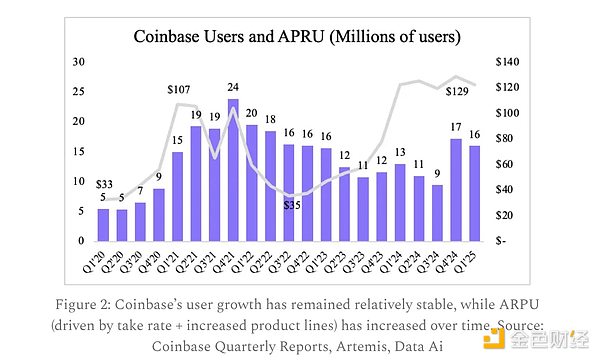
Why Coinbase's bet on Circle or USDC is not risk-free
While the Coinbase ecosystem strategy is attractive, it complicates the investment thesis. The wide range of Coinbase's businesses means it cannot be viewed as a pure proxy for USDC or Circle. Currently, USDC-related revenue accounts for only about 15% of Coinbase's total revenue, far less than the transaction fees from its exchange business. However, this core revenue source is facing increasing pressure due to growing competition from ETFs, decentralized exchanges (DEXs), and traditional financial platforms such as Robinhood. Therefore, buying Coinbase as an alternative to Circle or USDC exposure is not a pure investment option. In response to the fierce competition in its traditional business, Coinbase seeks to diversify its business beyond the trading business by building a broader and more durable business model. Currently, Coinbase's business mainly covers four areas:
1. Cryptocurrency Exchange Business: This is the core exchange business, and its revenue comes from trading fees.
2. Subscriptions and Blockchain Rewards: Includes products such as Coinbase One and institutional staking/custody as additional services to the exchange business.
3. USDC and Interest Income: This revenue source comes from the interest earned on the USDC reserves and the interest income generated by the cash held on the Coinbase balance sheet.
4. Base (Layer 2 Network): Transaction revenue from its Ethereum Layer 2 chain.
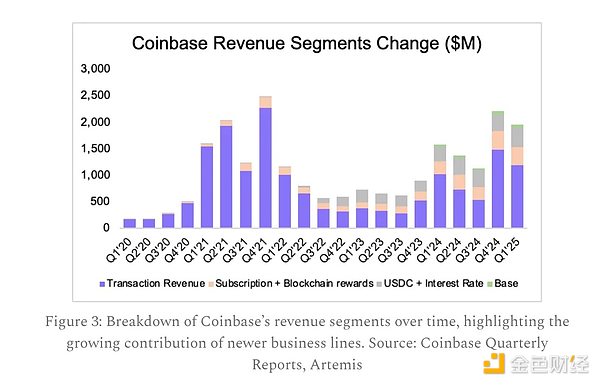
USDC's Rally: Volumes Grow, Advantages Narrow
For investors excited about Circle's IPO, Coinbase's bullish case often centers on its stablecoin business. USDC adoption is growing: more than 8 million of the 30 million active stablecoin addresses use USDC, and weekly transactions now exceed 300 million. The momentum shows no signs of slowing, and a comprehensive report from Artemis provides further insight into the size and rapid development of the stablecoin ecosystem. Coinbase earns revenue from U.S. Treasuries backing USDC and shares it with Circle. As USDC’s market cap approaches all-time highs, Coinbase’s stablecoin-related revenue has grown to $1 billion annualized, or about 20% of Coinbase’s total revenue. With Circle’s successful IPO (valued at about $34 billion), Coinbase (which controls about 60% of the USDC-related economy) holds about $51 billion in the USDC ecosystem, or about 76% of its current market cap.
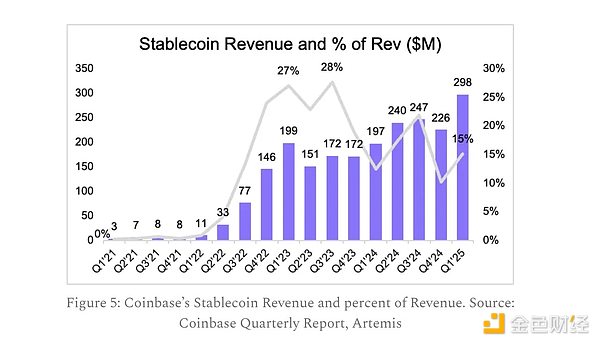 However, this figure masks the value that Coinbase actually retains. About half of the stablecoin-related revenue is returned to users in the form of earnings. Coinbase currently offers this return mechanism as a marketing strategy to retain users. But with competitors such as Robinhood now offering earnings on idle funds, this return mechanism may no longer be optional. Therefore, Coinbase's actual net income is closer to $171 million per quarter, accounting for only 57% of total revenue.
However, this figure masks the value that Coinbase actually retains. About half of the stablecoin-related revenue is returned to users in the form of earnings. Coinbase currently offers this return mechanism as a marketing strategy to retain users. But with competitors such as Robinhood now offering earnings on idle funds, this return mechanism may no longer be optional. Therefore, Coinbase's actual net income is closer to $171 million per quarter, accounting for only 57% of total revenue.
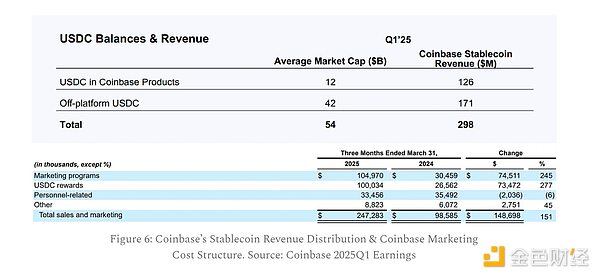 In addition, USDC has long positioned itself as a compliant stablecoin that is closely tied to the US dollar ecosystem. Many believe that the United States may take regulatory actions similar to BUSD on USDT, which is an asymmetric positive for USDC. Despite the expected regulatory pressure on USDT, it still dominates, accounting for about 75% of US stablecoin transactions and maintains a strong lead. After the collapse of Silicon Valley Bank, USDC has been slow to recover and has performed poorly in regions such as Canada, Bermuda, and Puerto Rico. Meanwhile, Cantor Fitzgerald holds a 5% stake in Tether and manages its $134 billion in assets under the leadership of Howard Lutnick, suggesting a reduction in regulatory risk, which weakens USDC's compliance advantage.
In addition, USDC has long positioned itself as a compliant stablecoin that is closely tied to the US dollar ecosystem. Many believe that the United States may take regulatory actions similar to BUSD on USDT, which is an asymmetric positive for USDC. Despite the expected regulatory pressure on USDT, it still dominates, accounting for about 75% of US stablecoin transactions and maintains a strong lead. After the collapse of Silicon Valley Bank, USDC has been slow to recover and has performed poorly in regions such as Canada, Bermuda, and Puerto Rico. Meanwhile, Cantor Fitzgerald holds a 5% stake in Tether and manages its $134 billion in assets under the leadership of Howard Lutnick, suggesting a reduction in regulatory risk, which weakens USDC's compliance advantage.
 In summary, Coinbase can only benefit a small part from USDC's rise because it shares an economic model with Circle. As Tether still dominates, USDC's potential market share growth remains limited, which also limits Coinbase's exposure. While Circle's stock price has risen parabolically, this largely reflects its expectations for future growth, especially in the payment field. Since Coinbase’s contribution to USDC growth comes primarily from its trading platform, its participation in the next phase of stablecoin-driven gains is limited. Therefore, supporting Circle directly rather than through Coinbase more clearly expresses a bullish view on Circle. The following sections explore the growing pressures facing Coinbase’s other business lines, including its core exchange and on-chain infrastructure.
In summary, Coinbase can only benefit a small part from USDC's rise because it shares an economic model with Circle. As Tether still dominates, USDC's potential market share growth remains limited, which also limits Coinbase's exposure. While Circle's stock price has risen parabolically, this largely reflects its expectations for future growth, especially in the payment field. Since Coinbase’s contribution to USDC growth comes primarily from its trading platform, its participation in the next phase of stablecoin-driven gains is limited. Therefore, supporting Circle directly rather than through Coinbase more clearly expresses a bullish view on Circle. The following sections explore the growing pressures facing Coinbase’s other business lines, including its core exchange and on-chain infrastructure.
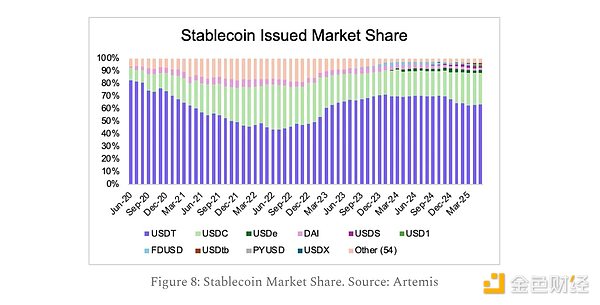
Exchange Business: ETFs, DEXs, and the Erosion of Moats
Historically, the exchange business has been driven by the supply side. This means that users choose exchanges that list the assets they need. When legal compliance is no longer an issue, demand is more about which exchange can offer the latest hot or high-return tokens than brand loyalty. Emerging or popular tokens (especially in the speculative or meme categories) often trigger a sudden surge in user activity, and listing a popular asset can significantly increase the trading volume and active users of an exchange.
There are generally three different types of tokens in the market:
1. Blue chip assets - highly liquid, trusted, and generally considered "safe" (e.g. BTC, ETH, SOL).
2. Legally safer/venture capital-backed tokens - backed by a trusted team or have a certain degree of regulatory compliance (e.g. ADA, XRP, LINK).
3. Speculative/Meme coins - high risk, high return; often drive a surge in participation (e.g. FLOKI, APE, TURBO).
Prior to this cycle, Coinbase led the US market in all major token categories with its wide range of listed assets and diverse trading pairs. However, the exchange landscape has changed dramatically. First, the rise of cryptocurrency ETFs has created a regulated and institution-friendly entry point, accelerating mainstream adoption and allowing traditional capital to enter the space without relying on platforms such as Coinbase. Institutional adoption has gained momentum, with Bitcoin ETFs surpassing $100 billion in assets under management in a single year. In particular, BlackRock's IBIT ETF has surpassed the 20-year assets under management of its gold ETF in less than 12 months, highlighting the strong institutional interest in cryptocurrencies. While ETFs have expanded access to blue-chip assets such as BTC and ETH, they have also undermined a key advantage for Coinbase - as the primary compliant platform for cryptocurrency investment in the United States. The growth opportunities that Coinbase once enjoyed exclusively are now shared by ETF tools, and in some cases even redirected. More and more new U.S. investors are entering the cryptocurrency market through ETFs rather than Coinbase, marking a shift in mainstream investment channels. Although Coinbase earns custody fees from some ETFs, these revenues are insignificant compared to the high transaction fees it previously relied on.
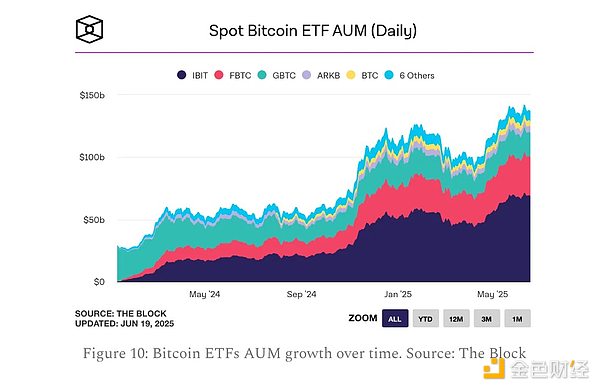
On the other hand, the explosive growth of Meme coins has triggered a new wave of retail speculation, strengthening the speculative nature of cryptocurrencies. Tools such as Pump.fun, Raydium and Jupiter have made token issuance easier than ever, resulting in a nearly 30-fold increase in the number of tokens since the last cycle. Due to its strict compliance standards, Coinbase has been lagging behind in listing small or meme-based tokens, unable to keep up with the influx of new coins. In contrast, decentralized exchanges (DEXs) have surged in popularity, providing instant liquidity for almost all tokens through permissionless, AMM-based trading. This gives DEXs a significant advantage in speed and flexibility - anyone can list and anyone can trade. For users seeking early, high-risk, high-reward opportunities (especially in the meme coin space), DEXs are often the only viable option.
Coinbase’s disadvantage is further exacerbated by the platform’s limited integration with the Solana ecosystem — which has become the center of meme coin activity today. As a result, Coinbase has largely missed out on the Solana meme coin craze, while DEXs such as Raydium and Jupiter have captured the associated trading volume and user engagement.
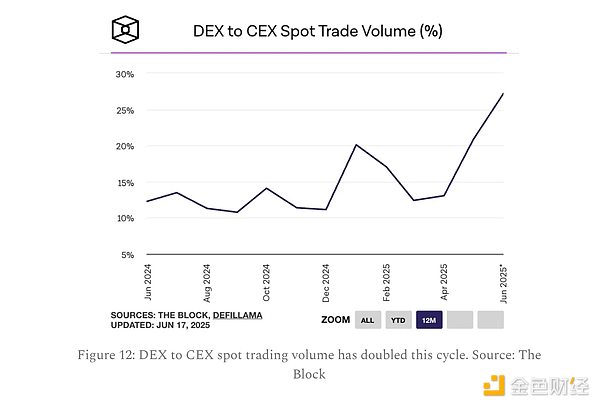 In addition to the rise of ETFs and meme coins, the Trump administration has also sent more friendly signals to cryptocurrencies, aiming to increase regulatory clarity and end the strong crackdown on the industry. For example, Trump’s newly appointed SEC Chairman Paul Atkins quickly moved to reverse Gary Gensler’s tough enforcement measures against platforms like Coinbase and Kraken during the Biden administration.
In addition to the rise of ETFs and meme coins, the Trump administration has also sent more friendly signals to cryptocurrencies, aiming to increase regulatory clarity and end the strong crackdown on the industry. For example, Trump’s newly appointed SEC Chairman Paul Atkins quickly moved to reverse Gary Gensler’s tough enforcement measures against platforms like Coinbase and Kraken during the Biden administration.
As a result, traditional financial platforms with a strong retail presence like Robinhood have scaled up their token offerings to boost market share. This shift is evident in the data: Robinhood’s retail revenue rose from 32% to 76% of Coinbase’s by the fourth quarter of 2024, highlighting Coinbase’s declining market share. While regulatory clarity appears to be a boon for Coinbase, it also lowers barriers to entry. Previously, strict compliance policies favored well-resourced companies like Coinbase; under the new, more relaxed regulatory regime, smaller exchanges and traditional financial platforms can compete more effectively. To quantify this competitive dynamic, increased competition in all areas of cryptocurrency should put more pressure on Coinbase to lower its notoriously high fees or risk losing market share. In fact, Coinbase’s share of dollar-backed trading volume has fallen — from a peak of 60% to around 50% today, having fallen as low as 32% at the height of the meme coin craze. More importantly, Coinbase's trading commission rate has also dropped significantly - from a peak of 2.5% to around 1.4%. If it weren't for the recent launch of derivatives, the drop would have been even greater. It is worth noting that Coinbase's commission rate soared after the FTX crash at the end of 2022, when Coinbase enjoyed a near-monopoly in the U.S. market. This trend peaked in the fourth quarter of 2023, just before the launch of the Bitcoin ETF, marking a more competitive and institutional phase in cryptocurrency trading.
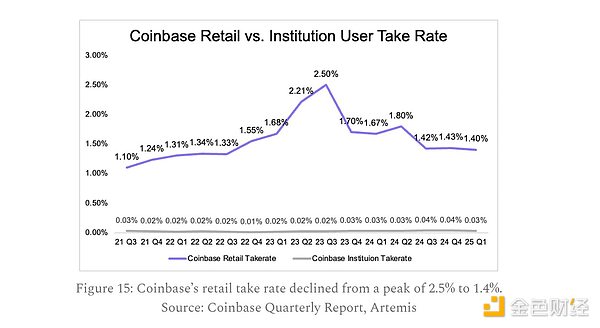 It can be seen that the competitive landscape of Coinbase has changed dramatically in this cycle. The key links in Coinbase's core funnel - from exchanges to on-chain economies - face severe challenges. As shown in the figure above, the peak of active users is only 70% of the peak in 2021. Although Coinbase currently faces huge competition, there are three profitable businesses that may become its core pillars: the derivatives market (Coinbase International), USDC, and Base.
It can be seen that the competitive landscape of Coinbase has changed dramatically in this cycle. The key links in Coinbase's core funnel - from exchanges to on-chain economies - face severe challenges. As shown in the figure above, the peak of active users is only 70% of the peak in 2021. Although Coinbase currently faces huge competition, there are three profitable businesses that may become its core pillars: the derivatives market (Coinbase International), USDC, and Base.
Derivatives Market: Futures without Futures?
Derivatives remain the most profitable part of cryptocurrency trading. In 2024, Coinbase launched a limited set of international derivatives products, which quickly became popular. While Q1 2025 results showed strong volume growth, Coinbase noted that derivatives are still in their early stages but could become key to profitability for institutional users. However, due to ongoing marketing efforts, rebates and liquidity incentives have so far offset institutional trading revenue, so derivatives have had limited impact on revenue.
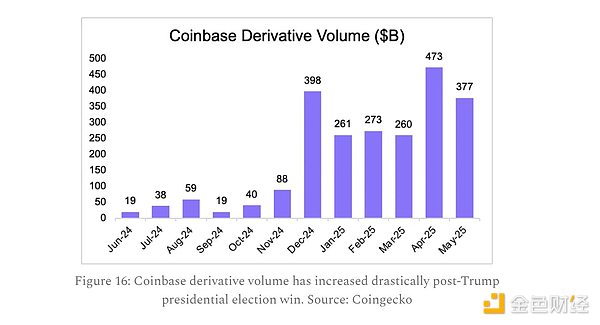 However, the main goal of launching derivatives in 2024 is to better monetize existing users and attract new users. Aside from a brief spike in the hot season in late 2024, international user growth has been minimal. While derivatives have brought in higher trading revenue, they have not significantly driven user growth. Importantly, derivatives revenue is embedded in Coinbase's broader trading business - without it, the platform's volume cut rate would likely be lower.
However, the main goal of launching derivatives in 2024 is to better monetize existing users and attract new users. Aside from a brief spike in the hot season in late 2024, international user growth has been minimal. While derivatives have brought in higher trading revenue, they have not significantly driven user growth. Importantly, derivatives revenue is embedded in Coinbase's broader trading business - without it, the platform's volume cut rate would likely be lower.
 In 2025, Coinbase began offering derivatives to US users to better monetize its domestic user base. However, the launch coincided with the rapid rise of Bitcoin options linked to ETFs, which may limit its upside. Since most derivatives are concentrated on blue-chip assets such as BTC and ETH, Coinbase faces direct competition from ETF options, which further limits the growth potential of this area.
In 2025, Coinbase began offering derivatives to US users to better monetize its domestic user base. However, the launch coincided with the rapid rise of Bitcoin options linked to ETFs, which may limit its upside. Since most derivatives are concentrated on blue-chip assets such as BTC and ETH, Coinbase faces direct competition from ETF options, which further limits the growth potential of this area.
In summary, while the derivatives division is an important revenue driver in the short term, Coinbase's position remains challenged unless it can expand the top of its funnel and attract new users in an increasingly crowded and fragmented trading market.
Base: Coinbase’s bet on on-chain infrastructure
Coinbase’s Ethereum Layer 2 scaling platform, Base, aims to help users integrate into the on-chain economy while diversifying Coinbase’s revenue beyond trading. Unlike other Layer 2 platforms, Base uses ETH as its native currency and has no native token. With Coinbase’s brand and support, Base has quickly gained popularity driven by popular applications such as Farcaster, and became the Ethereum Layer 2 platform with the highest transaction volume in its first year, and also ranked first in terms of daily users and total locked value. Coinbase derives tremendous value from operating Base, with revenue derived from transaction fees minus Layer 1 costs. Base makes approximately $1 million in gross profit per week, with a profit margin of approximately 90%. In addition, Base contributes more than 75% of all Layer 2 gross profits, highlighting its efficiency and market dominance. In addition to sequencer fees, Base also introduces users to Coinbase's ecosystem through its wallet and applications, and generates revenue through cryptocurrency purchases, transactions, and Base native applications. Base also powers Coinbase’s B2B products such as Cloud, OnchainKit, and SDKs, and through a partnership with Optimism, Coinbase could receive up to 118 million OP tokens over the next six years that will be tied to Base’s growth.
Base’s core limitation is its modular Ethereum Layer 2 architecture, which creates a split between liquidity, users, and developers. Bridging assets from Ethereum adds friction, while limited interoperability between Layer 2s also prevents seamless integration. These issues stem from differences in blockchain finality, making cross-chain liquidity transfers slow, costly, and complex. Despite tools like AggLayer and bridges, modular structure remains a challenge. Despite Base’s rapid growth, its adoption (measured in active users and transaction volume) still lags behind more unified, scalable monolithic chains such as Solana, which has three times the number of daily active users and seven times the daily transaction volume of Base.

How much is Coinbase worth? Categorical valuation method
We will adopt the sum-of-the-parts valuation method, which is divided into the following parts:
1. Exchange business - including trading revenue, subscriptions and services, and blockchain rewards
2. Base revenue - revenue generated by Coinbase's layer 2 network Base
3. USDC revenue - Coinbase's share of revenue from its partnership with Circle
4. Interest income - interest income on cash and USDC reserves
Fundamentally, Coinbase's trading business is both cyclical and increasingly competitive. To value it, we applied the average revenue multiple of traditional brokerage firms, which reflects a more stable and mature market structure.
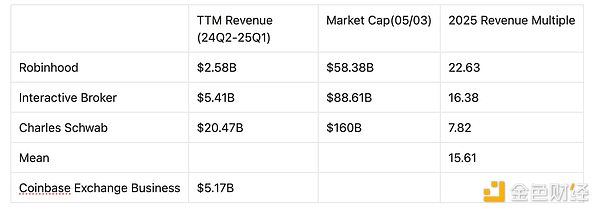 Applying this multiple, Coinbase's trading business is valued at: $5.17 billion × 15.61 = $80.7 billion.
Applying this multiple, Coinbase's trading business is valued at: $5.17 billion × 15.61 = $80.7 billion.
As part of our bullish thesis for Base, we applied the average P/E/Revenue multiple observed between Optimism (OP) and Arbitrum (ARB), which is approximately 270x. Applying this value to Base's annualized revenue of $68.7 million yields an implied market cap of: $68.7 million × 270 = $18.5 billion.
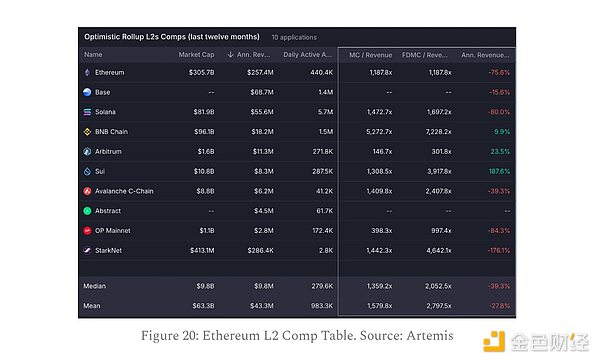 However, our fundamental argument uses a traditional tech valuation framework. Using a 30x price-to-gross multiple and assuming a gross margin of approximately 90%, Base's implied gross profit is approximately $61.8 million, resulting in a more conservative market cap valuation of $61.8 million × 30 = $1.86 billion.
However, our fundamental argument uses a traditional tech valuation framework. Using a 30x price-to-gross multiple and assuming a gross margin of approximately 90%, Base's implied gross profit is approximately $61.8 million, resulting in a more conservative market cap valuation of $61.8 million × 30 = $1.86 billion.
This contrast highlights the huge valuation gap between token-based models and traditional financial frameworks. Given the speculative nature of current token valuation multiples, our analysis is based on a more fundamentally focused traditional financial model.
Since Circle has completed its IPO, valuing Coinbase's USDC-related business is relatively simple. Circle is currently valued at ~$34 billion (June 16, 2025), reflecting its 40% share of USDC revenue. Since Coinbase receives the remaining 60% of USDC revenue and retains ~57% of it as net income (after distributing earnings to users), we can estimate the value of Coinbase’s USDC-related business as follows: $34 billion × (6 ÷ 4) × 57% = ~$29.07 billion. Coinbase earns nearly $300 million in interest income per year on its $8 billion cash reserves. We directly account for the value of its assets in the sum-of-the-parts method, which yields $8 billion.

According to our disaggregated valuation approach, Coinbase could be valued at approximately $95.7 billion, meaning the market may be undervaluing the company. However, this apparent discount reflects real and substantial risk.
Conclusion: Coinbase’s Diversified Ecosystem Faces Competition on All Sides
Coinbase’s core trading business is under continued pressure from structural factors: ETF-driven disintermediation, fee compression on decentralized exchanges (DEXs), and slowing user acquisition. Meanwhile, newer revenue pillars such as Base and USDC, while strategically important, face increasing competition in their respective markets. USDC and interest income are also sensitive to falling interest rates and yield pass-through pressures, which limit margin access.
In short, Coinbase is evolving into a diversified crypto ecosystem, but every part of that model now faces headwinds. While Coinbase may be undervalued from a purely financial perspective, the market's caution reflects that its shrinking moat, pressured margins, and increased competitive vulnerability are reasonably priced in.
 Kikyo
Kikyo

 As Coinbase's brand and influence continue to expand, Coinbase and Circle launched USDC, a stablecoin positioned as a compliant alternative to USDT and BUSD. As a key bridge between fiat and cryptocurrency, Coinbase's platform integration and reputation have accelerated the popularity of USDC. Rising interest rates (up to around 5%) have further increased the interest income of USDC reserves.
As Coinbase's brand and influence continue to expand, Coinbase and Circle launched USDC, a stablecoin positioned as a compliant alternative to USDT and BUSD. As a key bridge between fiat and cryptocurrency, Coinbase's platform integration and reputation have accelerated the popularity of USDC. Rising interest rates (up to around 5%) have further increased the interest income of USDC reserves. 

 However, this figure masks the value that Coinbase actually retains. About half of the stablecoin-related revenue is returned to users in the form of earnings. Coinbase currently offers this return mechanism as a marketing strategy to retain users. But with competitors such as Robinhood now offering earnings on idle funds, this return mechanism may no longer be optional. Therefore, Coinbase's actual net income is closer to $171 million per quarter, accounting for only 57% of total revenue.
However, this figure masks the value that Coinbase actually retains. About half of the stablecoin-related revenue is returned to users in the form of earnings. Coinbase currently offers this return mechanism as a marketing strategy to retain users. But with competitors such as Robinhood now offering earnings on idle funds, this return mechanism may no longer be optional. Therefore, Coinbase's actual net income is closer to $171 million per quarter, accounting for only 57% of total revenue.  In addition, USDC has long positioned itself as a compliant stablecoin that is closely tied to the US dollar ecosystem. Many believe that the United States may take regulatory actions similar to BUSD on USDT, which is an asymmetric positive for USDC. Despite the expected regulatory pressure on USDT, it still dominates, accounting for about 75% of US stablecoin transactions and maintains a strong lead. After the collapse of Silicon Valley Bank, USDC has been slow to recover and has performed poorly in regions such as Canada, Bermuda, and Puerto Rico. Meanwhile, Cantor Fitzgerald holds a 5% stake in Tether and manages its $134 billion in assets under the leadership of Howard Lutnick, suggesting a reduction in regulatory risk, which weakens USDC's compliance advantage.
In addition, USDC has long positioned itself as a compliant stablecoin that is closely tied to the US dollar ecosystem. Many believe that the United States may take regulatory actions similar to BUSD on USDT, which is an asymmetric positive for USDC. Despite the expected regulatory pressure on USDT, it still dominates, accounting for about 75% of US stablecoin transactions and maintains a strong lead. After the collapse of Silicon Valley Bank, USDC has been slow to recover and has performed poorly in regions such as Canada, Bermuda, and Puerto Rico. Meanwhile, Cantor Fitzgerald holds a 5% stake in Tether and manages its $134 billion in assets under the leadership of Howard Lutnick, suggesting a reduction in regulatory risk, which weakens USDC's compliance advantage. In summary, Coinbase can only benefit a small part from USDC's rise because it shares an economic model with Circle. As Tether still dominates, USDC's potential market share growth remains limited, which also limits Coinbase's exposure. While Circle's stock price has risen parabolically, this largely reflects its expectations for future growth, especially in the payment field. Since Coinbase’s contribution to USDC growth comes primarily from its trading platform, its participation in the next phase of stablecoin-driven gains is limited. Therefore, supporting Circle directly rather than through Coinbase more clearly expresses a bullish view on Circle. The following sections explore the growing pressures facing Coinbase’s other business lines, including its core exchange and on-chain infrastructure.
In summary, Coinbase can only benefit a small part from USDC's rise because it shares an economic model with Circle. As Tether still dominates, USDC's potential market share growth remains limited, which also limits Coinbase's exposure. While Circle's stock price has risen parabolically, this largely reflects its expectations for future growth, especially in the payment field. Since Coinbase’s contribution to USDC growth comes primarily from its trading platform, its participation in the next phase of stablecoin-driven gains is limited. Therefore, supporting Circle directly rather than through Coinbase more clearly expresses a bullish view on Circle. The following sections explore the growing pressures facing Coinbase’s other business lines, including its core exchange and on-chain infrastructure. 

 In addition to the rise of ETFs and meme coins, the Trump administration has also sent more friendly signals to cryptocurrencies, aiming to increase regulatory clarity and end the strong crackdown on the industry. For example, Trump’s newly appointed SEC Chairman Paul Atkins quickly moved to reverse Gary Gensler’s tough enforcement measures against platforms like Coinbase and Kraken during the Biden administration.
In addition to the rise of ETFs and meme coins, the Trump administration has also sent more friendly signals to cryptocurrencies, aiming to increase regulatory clarity and end the strong crackdown on the industry. For example, Trump’s newly appointed SEC Chairman Paul Atkins quickly moved to reverse Gary Gensler’s tough enforcement measures against platforms like Coinbase and Kraken during the Biden administration. It can be seen that the competitive landscape of Coinbase has changed dramatically in this cycle. The key links in Coinbase's core funnel - from exchanges to on-chain economies - face severe challenges. As shown in the figure above, the peak of active users is only 70% of the peak in 2021. Although Coinbase currently faces huge competition, there are three profitable businesses that may become its core pillars: the derivatives market (Coinbase International), USDC, and Base.
It can be seen that the competitive landscape of Coinbase has changed dramatically in this cycle. The key links in Coinbase's core funnel - from exchanges to on-chain economies - face severe challenges. As shown in the figure above, the peak of active users is only 70% of the peak in 2021. Although Coinbase currently faces huge competition, there are three profitable businesses that may become its core pillars: the derivatives market (Coinbase International), USDC, and Base.  However, the main goal of launching derivatives in 2024 is to better monetize existing users and attract new users. Aside from a brief spike in the hot season in late 2024, international user growth has been minimal. While derivatives have brought in higher trading revenue, they have not significantly driven user growth. Importantly, derivatives revenue is embedded in Coinbase's broader trading business - without it, the platform's volume cut rate would likely be lower.
However, the main goal of launching derivatives in 2024 is to better monetize existing users and attract new users. Aside from a brief spike in the hot season in late 2024, international user growth has been minimal. While derivatives have brought in higher trading revenue, they have not significantly driven user growth. Importantly, derivatives revenue is embedded in Coinbase's broader trading business - without it, the platform's volume cut rate would likely be lower.  In 2025, Coinbase began offering derivatives to US users to better monetize its domestic user base. However, the launch coincided with the rapid rise of Bitcoin options linked to ETFs, which may limit its upside. Since most derivatives are concentrated on blue-chip assets such as BTC and ETH, Coinbase faces direct competition from ETF options, which further limits the growth potential of this area.
In 2025, Coinbase began offering derivatives to US users to better monetize its domestic user base. However, the launch coincided with the rapid rise of Bitcoin options linked to ETFs, which may limit its upside. Since most derivatives are concentrated on blue-chip assets such as BTC and ETH, Coinbase faces direct competition from ETF options, which further limits the growth potential of this area. 
 Applying this multiple, Coinbase's trading business is valued at: $5.17 billion × 15.61 = $80.7 billion.
Applying this multiple, Coinbase's trading business is valued at: $5.17 billion × 15.61 = $80.7 billion.  However, our fundamental argument uses a traditional tech valuation framework. Using a 30x price-to-gross multiple and assuming a gross margin of approximately 90%, Base's implied gross profit is approximately $61.8 million, resulting in a more conservative market cap valuation of $61.8 million × 30 = $1.86 billion.
However, our fundamental argument uses a traditional tech valuation framework. Using a 30x price-to-gross multiple and assuming a gross margin of approximately 90%, Base's implied gross profit is approximately $61.8 million, resulting in a more conservative market cap valuation of $61.8 million × 30 = $1.86 billion. 


